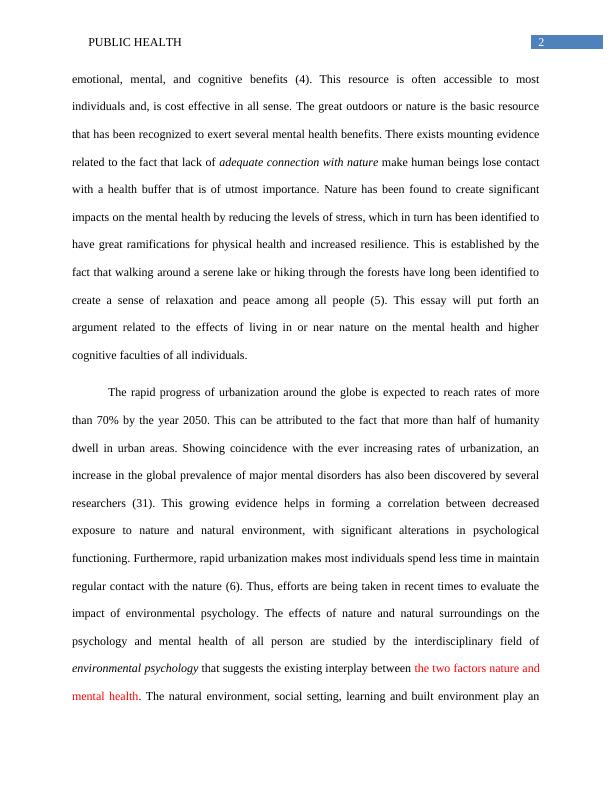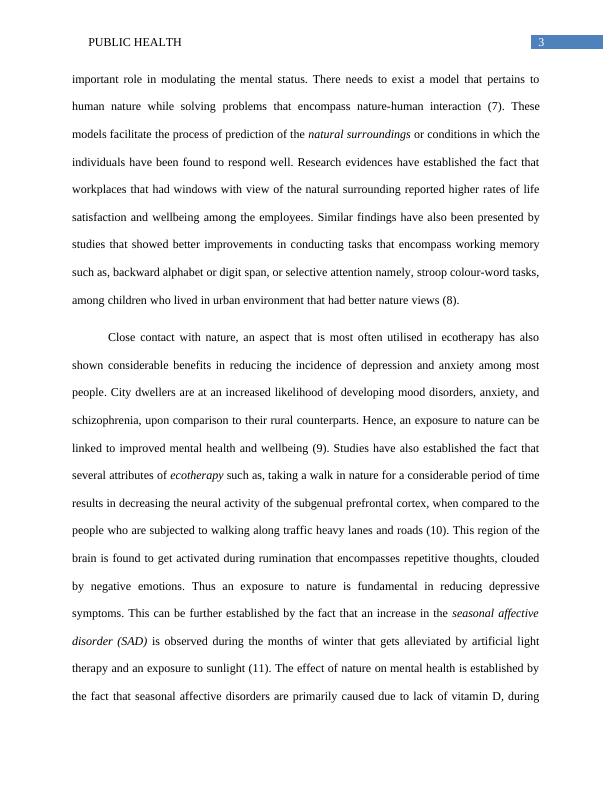Ask a question from expert
Sample Assignment on Public Health (pdf)
20 Pages6320 Words142 Views
Added on 2021-06-17
Sample Assignment on Public Health (pdf)
Added on 2021-06-17
BookmarkShareRelated Documents
Running head: PUBLIC HEALTHNature and mental health behaviourName of the StudentName of the UniversityAuthor Note

1PUBLIC HEALTHMental health refers to the level of psychological well-being of an individual and can bedefined as the psychological state of a person related to his/her functioning at a level thatsatisfies the emotional and behavioural adjustments. In other words, mental health includes theability of an individual to enjoy life and maintain a balance between the activities, therebyaccomplishing psychological resilience (1). The concepts of subjective wellbeing of a person, incombination of the autonomy and self-efficacy of the person are encompassed by mental health.A sound mental health also includes inter-generational dependence, competence and the inherentproperty of self-actualisation. Research evidence has established the fact that the well-being andmentalhealthof all individuals have shown an elevation upon experiencing certain levels ofconnection or engagement with the larger world, which exist outside the defined territories ofexistence (2). Thus, extending one beyond the preconceived notions and perceptions, show amarked improvement in the mental status of the concerned individual. All kinds of immersion inthe natural world have been found extremely beneficial in heightening the overall health andwellbeing, thereby reinforcing the need for engaging in positive engagement with the livingworld. Mental health most often includesthe individual capacity of moving outside that results inbroadening and increasing the emotional and mental perspectives about life, nature and people ingeneral (3). This realm grows, frommeditation to a state of mindfulnessstate that helps the person toremain grounded in an awareness of the current situation. Hence, it acts in the form of a bufferzone between getting influenced by thoughts and emotions about the past or makinganticipations about the impending future.Owing to the presence of a plethora of therapeutictechniques and tools that are present at the disposal of all, it has been found that mental healthpractitioners generally overlook a major resource that has the benefits of a multitude of

2PUBLIC HEALTHemotional, mental, and cognitive benefits (4). This resource is often accessible to mostindividuals and, is cost effective in all sense. The great outdoors or nature is the basic resourcethat has been recognized to exert several mental health benefits. There exists mounting evidencerelated to the fact that lack of adequate connection with nature make human beings lose contactwith a health buffer that is of utmost importance. Nature has been found to create significantimpacts on the mental health by reducing the levels of stress, which in turn has been identified tohave great ramifications for physical health and increased resilience. This is established by thefact that walking around a serene lake or hiking through the forests have long been identified tocreate a sense of relaxation and peace among all people (5). This essay will put forth anargument related to the effects of living in or near nature on the mental health and highercognitive faculties of all individuals. The rapid progress of urbanization around the globe is expected to reach rates of morethan 70% by the year 2050. This can be attributed to the fact that more than half of humanitydwell in urban areas. Showing coincidence with the ever increasing rates of urbanization, anincrease in the global prevalence of major mental disorders has also been discovered by severalresearchers (31). This growing evidence helps in forming a correlation between decreasedexposure to nature and natural environment, with significant alterations in psychologicalfunctioning. Furthermore, rapid urbanization makes most individuals spend less time in maintainregular contact with the nature (6). Thus, efforts are being taken in recent times to evaluate theimpact of environmental psychology. The effects of nature and natural surroundings on thepsychology and mental health of all person are studied by the interdisciplinary field ofenvironmental psychology that suggests the existing interplay between the two factors nature andmental health. The natural environment, social setting, learning and built environment play an

3PUBLIC HEALTHimportant role in modulating the mental status. There needs to exist a model that pertains tohuman nature while solving problems that encompass nature-human interaction (7). Thesemodels facilitate the process of prediction of the natural surroundings or conditions in which theindividuals have been found to respond well. Research evidences have established the fact thatworkplaces that had windows with view of the natural surrounding reported higher rates of lifesatisfaction and wellbeing among the employees. Similar findings have also been presented bystudies that showed better improvements in conducting tasks that encompass working memorysuch as, backward alphabet or digit span, or selective attention namely, stroop colour-word tasks,among children who lived in urban environment that had better nature views (8). Close contact with nature, an aspect that is most often utilised in ecotherapy has alsoshown considerable benefits in reducing the incidence of depression and anxiety among mostpeople. City dwellers are at an increased likelihood of developing mood disorders, anxiety, andschizophrenia, upon comparison to their rural counterparts. Hence, an exposure to nature can belinked to improved mental health and wellbeing (9). Studies have also established the fact thatseveral attributes of ecotherapy such as, taking a walk in nature for a considerable period of timeresults in decreasing the neural activity of the subgenual prefrontal cortex, when compared to thepeople who are subjected to walking along traffic heavy lanes and roads (10). This region of thebrain is found to get activated during rumination that encompasses repetitive thoughts, cloudedby negative emotions. Thus an exposure to nature is fundamental in reducing depressivesymptoms. This can be further established by the fact that an increase in the seasonal affectivedisorder (SAD) is observed during the months of winter that gets alleviated by artificial lighttherapy and an exposure to sunlight (11). The effect of nature on mental health is established bythe fact that seasonal affective disorders are primarily caused due to lack of vitamin D, during

End of preview
Want to access all the pages? Upload your documents or become a member.
Related Documents
Policy Analysis: South Australia's Mental Health and Wellbeing Policylg...
|12
|3346
|88
Mental Health: Understanding Stigma, Social Media, Nursing Challenges, and Cultural Beliefslg...
|9
|2478
|400
Impact of Constraints on Consumer Participation in Mental Health Care Serviceslg...
|14
|4155
|275
Effectiveness of Resilience and Mindfulness in Preventing Burnout among Human Service Professionalslg...
|9
|1747
|236
Health Sciences 2110B Resiliencelg...
|3
|645
|109
Promoting Mental Health and Wellbeing Among Older Peoplelg...
|16
|4816
|99